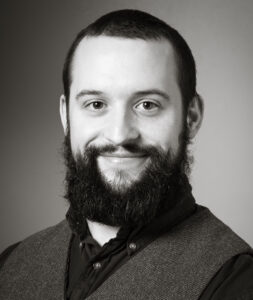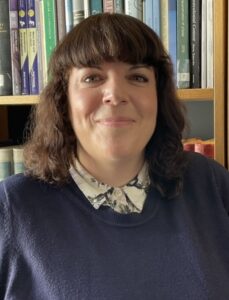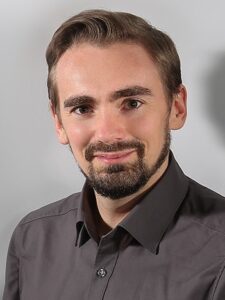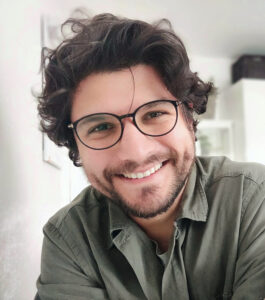Dagskrá í öfugri tímaröð (nýjast efst)/Program in reverse order (latest on top):
Ryder C. Patzuk-Russell
Financing Piety, Work, and Retirement
Exploring Próventa and Próventumenn
Fimmtudaginn 9. nóvember 2023 kl. 16.30 / Thursday, November 9, 2023, at 16.30
Fyrirlestrasal Eddu / Edda auditorium

The issue of retirement is at the center of the current reappraisal of Icelandic monasteries and monastic culture. In the past often viewed as little more than retirement homes for aristocrats, recent research has helped illuminate the variety of social and cultural functions Icelandic monasteries could perform. And yet, some medieval Icelanders did move to monasteries late in life, and lived at monasteries without living under the Rule. Retirement, in whatever form the concept can be understood in a medieval context, was a part of Icelandic monastic culture, but in a more complex and nuanced way than has yet been explored.
This paper will present preliminary research exploring the term próventa, its uses and significations, and its relationship to the idea of retirement. A próventa was a type of financial agreement, a payment for long term housing and services, made by a próventumaður. Most próventumenn lived at monasteries, but some also lived at cathedrals, or even outside any such major religious institution. Some of them worked, some had children. Examining the various meanings and contexts of the term próventa can thereby give us not only greater insight into monastic culture, but into medieval Icelandic social and religious history more broadly.
Ryder C. Patzuk-Russell is a Polonez Bis research fellow at the University of Silesia in Katowice. He finished his MA in Medieval Iceland Studies at the University of Iceland in 2012, and a PhD at the University of Birmingham in 2017. His first book, The Development of Education in Medieval Iceland, was published by De Gruyter and MIP in 2021. His current project, „Monasteries on the Edge of the World: Church and Society in Late Medieval Iceland,“ explores monastic history in Iceland from numerous perspectives, and he is also producing a new English translation of Lárentíus saga byskups.
Fyrirlesturinn verður haldinn á ensku og er öllum opinn. / The talk will be delivered in English and is open to all.
—o—o—o—
Ciaran McDonough
What relevance did medieval Irish law have in the nineteenth century?
Fimmtudaginn 2. nóvember 2023 kl. 16.30 / Thursday, November 2, 2023, at 16.30
Fyrirlestrasal Eddu / Edda auditorium

The project to translate the corpus of medieval Irish law was the antiquarian project of the longest duration in nineteenth-century Ireland, running between 1853 and 1901. At its inception, the proposed legal translations were widely anticipated for their purported potential in unlocking the secrets of Ireland’s “ancient” past. At the publication of the first volume in the series in 1865, European Celticists celebrated the work for its philological value. Yet, early Irish law has held a special place in the popular imagination for what various non-scholarly authors have imagined society under these laws to have been. Tying in with the idea of a golden age, this frequently includes an egalitarian society with little gender disparity and, as such, means that the laws were imagined to provide an alternative justice which was denied through official channels.
This lecture will focus on the afterlife of medieval Irish law by discussing the genesis and production of Ancient Laws and Institutes of Ireland and how this publication made the legal corpus more accessible for further use. It will begin with an overview of the medieval corpus before turning to previous attempts to translate the laws. The mid-nineteenth century will be discussed and will be set in the context of the pan-European phenomenon of medieval legal translations from around the same time period. It will then look at the project itself and the various problems which led to its long duration. The remainder of the presentation will examine how the publication and translation of the laws led to discussions about their contents and potential for use. This included Nationalist views about a potential law code for an imagined future independent Ireland; a court case where early Irish law was invoked in the 1930s and 1940s; and a series of articles on early Irish land law in a Norwegian newspaper in the 1880s.
Ciaran McDonough is a Marie Skłodowska Curie Fellow in the Institute of History at the University of Iceland, where she runs her project Medieval Irish and Medieval Icelandic Texts in Nineteenth-Century Translation. She was awarded a PhD by the University of Galway in 2017 for a thesis on nineteenth-century Irish antiquarian research. Her research focuses on antiquarian research and scholarly networks in nineteenth-century Europe.
Fyrirlesturinn verður haldinn á ensku og er öllum opinn. / The talk will be delivered in English and is open to all.
—o—o—o—
 Víkingar í austurvegi — Legends of the Eastern Vikings
Víkingar í austurvegi — Legends of the Eastern Vikings
Málþing á vegum Miðaldastofu Háskóla Íslands — A University of Iceland Centre for Medieval Studies Symposium
Föstudaginn 20. október 2023 kl. 14.00-17.00 — Friday, October 20, 2023, at 14.00-17.00
Fyrirlestrasal Eddu — Edda auditorium
—o—o—o—
Simon Halink
The Paradoxical Afterlives of a Heathen Chieftain and a Catholic Martyr
On the Role of Þrándur í Götu and Bishop Jón Arason in Modern National Discourses
Fimmtudaginn 12. október 2023 kl. 16.30 / Thursday, October 12, 2023, at 16.30
Fyrirlestrasal Eddu / Edda auditorium

What do a pagan chieftain from the Faroe Islands and a sixteenth-century Catholic bishop from Iceland have in common? Maybe not all that much, at first glance. However, upon closer inspection, the two historical figures have played rather similar roles in the collective memory of their respective peoples. In this lecture, I will examine, from a comparative perspective, the link between the cultural memory of conversion events (such as Christianization and the Protestant Reformation) and modern national identity discourses of Iceland and the Faroe Islands.
With the rise of secular ideologies (notably nationalism) in the course of the nineteenth century, political values such as national self-determination and authenticity oftentimes trumped the traditional values and religious ideals of previous generations. In this presentation, I will explore the multiple (and often paradoxical) ways in which the ideological rewriting of the past, in the new genre of ‘national history,’ radically transformed the normative value attributed to these national narratives’ protagonists and antagonists. Especially the ideological inversion of medieval and early modern conversion narratives (Christianization and the Protestant Reformation, respectively) has led to the refashioning of heathen villains and heretics into national heroes and freedom fighters, with the traditional heroes of these stories (saintly missionaries and reformers) now serving as the destroyers of national authenticity, usually in the name of a foreign and power-hungry monarch. Especially in the modern cultural memory of smaller cultural communities such as Iceland and the Faroe Islands, the ‘traumatic’ loss of independence in the Middle Ages, as well as the strengthening of foreign controle in the wake of the Reformation, are intimately intertwined with the memory of the religious transitions of those periods.
To illustrate this historiographical transformation of ‘good guys’ into ‘bad guys’ and vice versa, I will offer a comparative analysis of two case studies, namely the pagan chieftain Tróndur í Gøtu (Þrándur í Götu in modern Icelandic), who (according to Færeyinga saga) forcefully resisted the Christianization of the Faroe Islands from Norway (c. 1000 AD), and the Icelandic bishop Jón Arason, who defended Catholicism against the Lutheran Reformation imposed by the Danish authorities and was consequently beheaded in 1550 AD. Paradoxically, this Catholic martyr would later be hailed by Icelandic nationalists as a hero of their Lutheran nation, and a defender of Iceland’s autonomy and authenticity.
Simon Halink is a cultural historian at the Fryske Akademy in Leeuwarden, the Netherlands. He has previously worked as an Assistant Professor in modern European history at Leiden University, with a main research interest in the development of national identities and national movements in the course of the ‘long nineteenth century’.
Fyrirlesturinn verður haldinn á ensku og er öllum opinn. / The talk will be delivered in English and is open to all.
—o—o—o—
Pierre-Brice Stahl
Vafþrúðnismál: A Fair and Just Riddle Contest
Fimmtudaginn 28. september 2023 kl. 16.30 / Thursday, September 28, 2023, at 16.30
Fyrirlestrasal Eddu / Edda auditorium

The poem Vafþrúðnismál features the meeting between two mythological figures, the giant Vafþrúðnir and the god Óðinn, who engage in a verbal duel. A close analysis of the text and the genre of questions reveals that Óðinn is not seeking to acquire knowledge through his questions to the giant. The analysis of the nature of the interaction provides a new understanding of the poem and provides insights into various aspects of the poem that have previously been considered problematic. The presentation will demonstrate that the distribution of questions between the two protagonists adheres to a specific logic inherent in the text. Similarly, the analysis of the final riddle reveals that it is not ‘unfair,’ as traditionally interpreted, but serves a specific function: demonstrating Óðinn’s almighty knowledge.
Pierre-Brice Stahl is an Associate Professor of the History of Religion in Nordic Studies at Sorbonne University. He currently serves as the President of the French-speaking Association of Nordic Studies and as the Director of the Bachelor’s Degree program in Nordic Studies at Sorbonne University. His research focuses on pre-Christian religions of the North, as well as riddles and riddling. In 2022, he received his Habilitation for his research on the modern and contemporary reception of Old Norse Mythology.
Fyrirlesturinn verður haldinn á ensku og er öllum opinn. / The talk will be delivered in English and is open to all.
—o—o—o—
Trish Baer
MyNDIR Insights: Visual Literacy and Retellings of Norse Mythology (1857–1919)
Þriðjudaginn 26. september 2023 kl. 16.30 / Tuesday, September 26, 2023, at 16.30
Fyrirlestrasal Eddu / Edda auditorium

MyNDIR (My Norse Digital Image Repository) was launched in June 2013 at the University of Victoria, B.C., Canada. In May 2020, MyNDIR received an Insight Development Grant to add images from the Victorian/Edwardian retellings of Norse mythology and sagas. This presentation will begin with MyNDIR and then focus on images concerning 1) the Victorian makeover of the role of Óðinn and 2) the unstable iconography of Þórr’s hammer. The presentation will conclude with illustrations from Victorian poetry periodicals.
In the hands of Victorian/Edwardian storytellers and illustrators, the Old Norse myths were bowdlerized, moralized, Christianized, and merged with folk and fairy tales. This observation concerning the texts is not new, though the illustrations within the books remain largely unexamined. The sociocultural details of the iconography within the illustrations contain evidence regarding the reception of—and the resulting transmission of—the primary sources.
The role of Óðinn was repurposed when Annie and Liza Keary published The Heroes of Asgard, or Tales From Scandinavian Mythology in 1857. The Keary sisters’ retelling of the Old Norse myths inspired further retellings with Victorian sensibilities. The Kearys present Óðinn as a type of father figure, a kind of colonial ruler whose character remains acceptable today to disparate groups such as Christian homeschoolers and New Age practitioners. The many editions ranging from 1857–2012 and enduring popularity of The Heroes of Asgard raises questions of its cultural value for current readers, and homeschoolers as well, a hundred and sixty-five years after its first publication.
In the primary sources, Mjöllnir is a sacred and ceremonial artifact used to hallow or consecrate births, deaths, weddings, and oaths. However, Þórr’s iconic short-handled hammer also figures prominently as an extraordinary weapon that he uses to defend the gods from the giants. Depictions of Mjöllnir vary a great deal in the Victorian/Edwardian illustrations. Sometimes it resembles a croquet mallet—or it’s only depicted in part or is completely absent. Distorted or diminished, Mjöllnir loses aspects of its fundamental cultural, iconographical, and mythological significance in the “retellings.”
The next version of MyNDIR will feature images and links to illustrations of Vikings from the Digital Victorian Periodical Poetry site. These images, and the poems that inspired them, provide further documentation concerning the Victorian reception of Norse primary sources that were preserved in Iceland and came to the attention of antiquarian scholars in the early 18th-century.
Trish Baer is Medieval Studies Adjunct Professor; ETCL Digital Scholarship Fellow; MyNDIR Editor; and SSHRC Insight Development Grant Project Lead at the University of Victoria, B.C., Canada. Baer’s research interests focus on visual literacy and the transmission and reception of illustrations of Norse mythology in manuscripts and early print books.
Fyrirlesturinn verður haldinn á ensku og er öllum opinn. / The talk will be delivered in English and is open to all.
—o—o—o—
Michael Micci
Sacred Space of Profane Tales
The Multifaceted Nature of Icelandic riddarasögur through the Case of Nitida saga
Fimmtudaginn 7. september 2023 kl. 16.30 / Thursday, September 7, 2023, at 16.30
Fyrirlestrasal Eddu / Edda auditorium
 In recent years, the perception of indigenous Icelandic riddarasögur has changed significantly within the scholarly community, from paltry products made for the distraction of Icelanders after the loss of political autonomy in 1262-64 to important testimonies of their time with a recognised literary value. After Geraldine Barnes’s 2014 The Bookish riddarasögur, the diverse kaleidoscope of sources and influences that have given shape to these narratives has been especially investigated in order to renegotiate their place and function in the context of medieval Icelandic literature. Nitida saga is among the most interesting texts that have been labelled as indigenous riddarasögur by literary critics, since it presents the typical features of Icelandic chivalric tales, particularly the so-called maiden-king sagas (meykónga sögur), while also redefining a large number of their fundamental elements.
In recent years, the perception of indigenous Icelandic riddarasögur has changed significantly within the scholarly community, from paltry products made for the distraction of Icelanders after the loss of political autonomy in 1262-64 to important testimonies of their time with a recognised literary value. After Geraldine Barnes’s 2014 The Bookish riddarasögur, the diverse kaleidoscope of sources and influences that have given shape to these narratives has been especially investigated in order to renegotiate their place and function in the context of medieval Icelandic literature. Nitida saga is among the most interesting texts that have been labelled as indigenous riddarasögur by literary critics, since it presents the typical features of Icelandic chivalric tales, particularly the so-called maiden-king sagas (meykónga sögur), while also redefining a large number of their fundamental elements.
The story of Nitida the Famous, queen of a fictional counterpart of France, courted by the world’s most valiant knights, who are ready to face perilous journeys and supernatural threats in order to win her hand, might look like an unambiguous and straightforward iteration of popular chivalric topoi. In fact, as recent research has demonstrated, the complexity of the Icelandic riddarasögur does not lie in their adventurous plots but rather in their unique way to successfully combine different and apparently conflicting narrative elements – both learned and popular, local and foreign. This paper will focus on the fictional space of Nitida saga as the main recipient of a religious symbolism derived from learned sources of clerical stamp which used to circulate in late-medieval Iceland. The proposed analysis should demonstrate that the most notable innovation carried out by the saga’s author is not to be found in Nitida as an unusually benevolent maiden-king but rather in the ways she interacts with both the physical and ideological landscape around her.
By constructing a space which is essentially allegorical and by carefully positioning Nitida in it, the author adopts a design that does not have the entertainment of the uneducated audience as its sole purpose. In fact, Nitida saga stimulates reflections on the characteristics of a good ruler, the relationship between gender and power, and even the reception of the crusading ideals in Iceland. As many indigenous riddarasögur, the text presents multiple levels of interpretation which hint at a multi-layered audience and at a variety of functions in the peculiar framework of 14th-century Iceland.
Michael Micci holds a Ph.D. in Icelandic Literature at the University of Iceland and is currently teaching Icelandic Language and Literature at the University of Milan. He specialised in the indigenous riddarasögur and their construction of narrative space, but his interests also involve Old Norse linguistics and textual criticism. He published the first Italian translation of Vápnfirðinga saga in 2023 and is currently working on a critical edition and translation of Nitida saga. Find out more about his work on Academia.edu or contact him at mim20@hi.is.
Fyrirlesturinn verður haldinn á ensku og er öllum opinn. / The talk will be delivered in English and is open to all.
—o—o—o—
